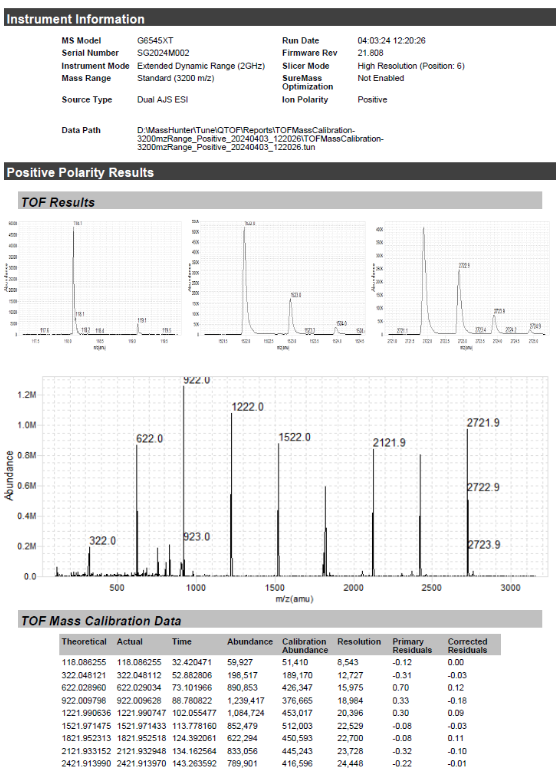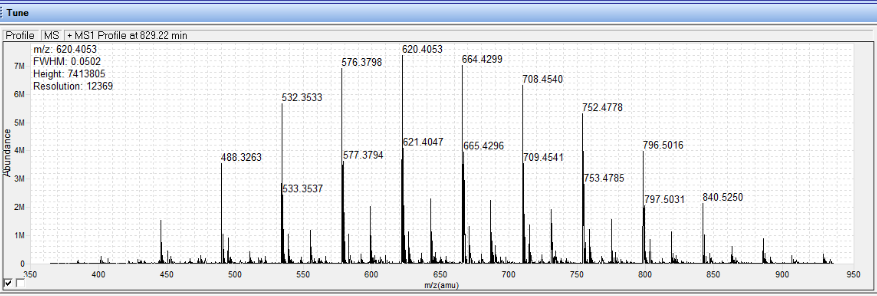Hi friends!
For starters, here is information about my equipment:
| Instrument | Model |
| 1290 Multisampler | G7167B |
| 1290 High Speed Pump | G7120A |
| 1290 Column Compartment | G7116B |
| 6545 XT LC/Q-TOF | G6549A |
| Reagents | Part Number | Lot |
| ESI-L Low Concentration Tuning Mix 100 mL | G1969-85000 | 0006768612 |
| 0.1 mM HP-0321 (in Biopolymer Reference Mass Kit) |
G1969-85003-1 |
0006760904 |
| Supelco Acetonitrile (LC/MS Grade) |
AX0156-1 |
63147 |
| Supelco Water (LC/MS Grade) |
WX0001-1 |
640005 |
Background: Yesterday morning, I created a new tune using the above reagents and have followed this guide: Diluting the Tune Mix on 6200 Series TOF and 6500 Series Q-TOF Systems - Articles - LC/MS Portal - Agilent Community. I made 2x of the tune mix, so a total of 200 mL consisted of 177 mL acetonitrile, 20 mL ESI-L tuning mix, 9 mL water, and 6 uL of 0.1 mM HP-0321. I did use a micropipette to add 5 mL of acetonitrile (1000 uL 5 times) and the 6 uL of the HP-0321. After adding the HP-0321, I did pipette up and down in the pipette tip to ensure all 6 uL were fully transferred to the bottle. I have made the tune mix similarly in the past. Immediately after creating the tune mix, I reported a Mass Calibration Check. Here is the tune report, which is normal (except for the abundances being this high, but it has been like this since the last source clean):

I perform a Mass Calibation Check every day because the instrument is used by multiple people every day. Today, when I performed the check, it seems there was excessive contamination:

I was trying to find similar situations online, and the only thing I could find was this: 6545 QTOF with noise at low mass and bad response at high mass - Forum - LC/MS - Agilent Community. I checked the differences in mass, and it's 44 m/z, so I feel this is PEG contamination.
Problem/Question: Where could this have come from when the tune mix was fine until this morning? No one would've touched Bottle B or tampered with it. I feel the only thing I could do differently to prevent this contamination is to use only glass graduated cylinders. The only thing I could thing of to use is a glass syringe for the biopolymer mix, but I don't know if I have one. I feel a micropipette should be fine for this, but I suppose I have to be more skeptical about what I can use. I have a second LC/QTOF (an IMS 6560 though), and the new tune mix shows all reference compounds well and fine. The source was last cleaned a week ago, and the last time the ion capillary tube was cleaned was 1-2 months ago. Although three different people used the instrument yesterday, whenever I elute calibrant, these PEG peaks appear, so I don't think it's contamination on the source or something or it'd always be there. The reason why this is a problem is because I am unable to tune the instrument and arrive at a "cannot perform course mass calibration" error.
I'm looking for thoughts, critiques, anecdotes, and anything else that can help me refine my procedure and technique while also better understanding the problem and how to avoid it.
Thanks friends!
